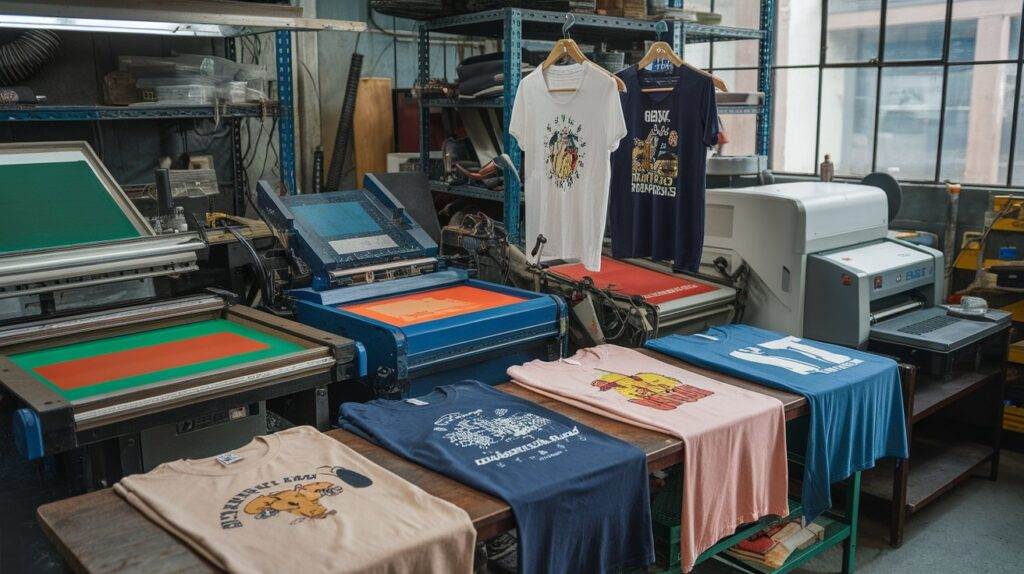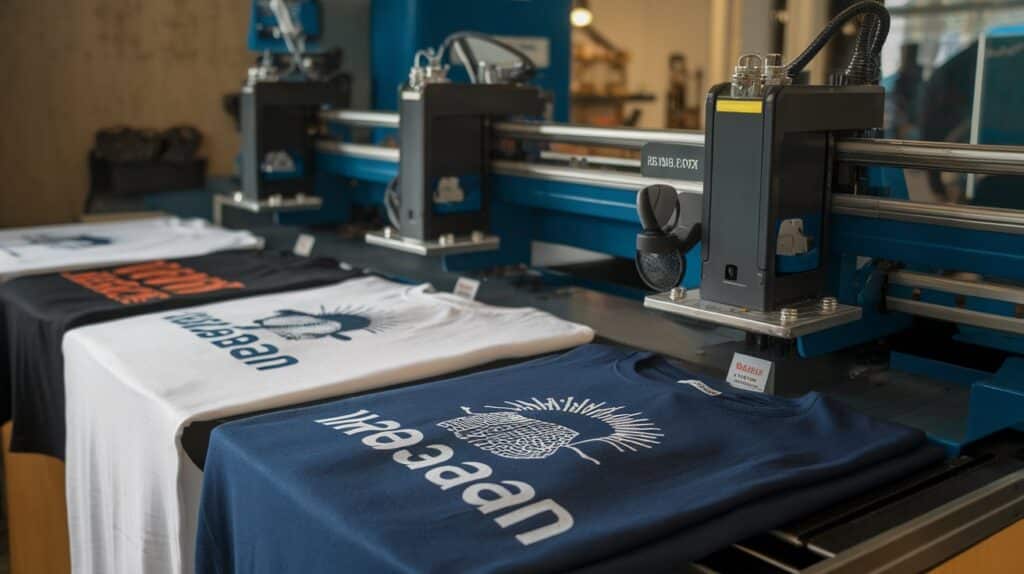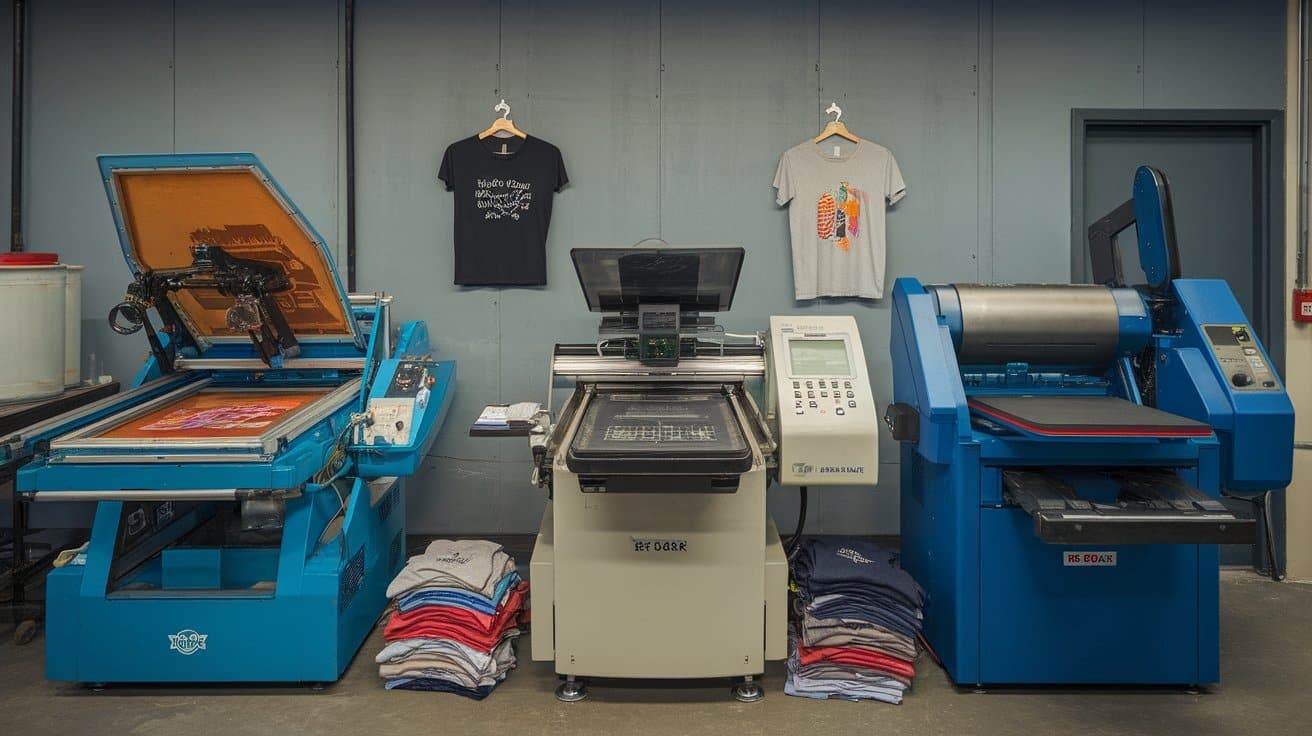Discover the ultimate guide to types of t-shirt printing machines, exploring essential shirt printing equipment and techniques. This guide covers the most common types of t-shirt printing methods and equipment to help you choose the best option for your needs.
Best T-Shirt Printing Method
When you’re picking a t-shirt printing method, you gotta think about a few important things. These factors will help you find the right technique for what you need.
Factors to Consider When Selecting a T-Shirt Printing Technique
- Printing Volume Requirements: First off, think about how many shirts you want to print at once. If you have big orders or need lots of shirts quickly, screen printing is usually faster and cheaper for larger batches. But if you’re just making a few custom designs for an event, Direct-to-Garment (DTG) printers are great since they let you change designs easily without much hassle.
- Design Complexity and Color Range: Next up is how detailed your designs are. Screen printing works well for simple graphics with not too many colors, but it might struggle with super detailed images. DTG is better for high-quality prints and complex designs, making it perfect for custom t-shirts that need bright colors and fine details.
- Fabric Type and Compatibility: Different fabrics work better with different printing methods. For example, dye sublimation is best on polyester because it makes the colors pop and last longer. Heat transfer can be used on many materials but might peel off after some time if not done right.
- Budget Constraints: Money matters! Look at both what it costs to buy the equipment and what you’ll spend on ink and maintenance later on. Screen printing needs a bigger upfront investment but can save you money in the long run when making lots of shirts. On the flip side, DTG printers cost less to start but have higher ink costs per shirt.
- Production Speed and Efficiency: Think about how fast you need those shirts printed. Once set up, screen printing can be quick for large amounts; however, DTG takes longer per shirt because of its detailed process but is flexible with design changes.
Essential Tips for Choosing the Right T-Shirt Printing Machine
- Assess Your Production Needs: Decide if you’re going big or just doing occasional custom pieces—this will help figure out if you need heavy-duty machines or smaller ones that fit in your home.
- Evaluate Cost vs. Production Capacity: Compare how much you’ll spend upfront against how many shirts you can make to make sure your machine fits within your budget without cutting into profits.
- Consider the Learning Curve and Ease of Use: Some machines take time to learn while others are easy to use right away—pick one that matches your team’s skills so production doesn’t slow down.
By thinking through these factors when choosing a t-shirt printing method and machine type specific to your needs will help improve both efficiency and quality in your projects!
Screen Printing- Traditional and Versatile
Screen printing is a popular way to make bright designs on t-shirts and other clothes. This classic method pushes ink through a mesh screen onto the fabric, making it easy to create bold colors and detailed designs. Many industries love this technique for its flexibility and effectiveness.
Screen Printing
The screen printing process starts with making a stencil or “screen” for each color in the design. You need a separate screen for every color layer. After preparing the screens, they are lined up on the garment, and ink is applied using a squeegee. This t-shirt printing method works great for large orders because it’s efficient and saves money. Here’s how it goes:
- Creating Screens: Each color needs its own screen.
- Aligning Screens: Getting them lined up right helps avoid mistakes.
- Applying Ink: A squeegee pushes the ink through the screens onto the fabric.
This process fits well with commercial printing equipment that can handle mass production printing.
Common Uses and Applications
Screen printing is used in many areas, making it a go-to choice for custom t-shirts, promotional apparel, and unique merchandise creation. Here are some common uses:
- Promotional Events: Businesses often use custom t-shirts to show off their brand.
- Sports Teams: Team jerseys usually have screen-printed designs.
- Fashion Incubators: New brands use this method to make special clothing lines.
These examples show just how flexible screen printing can be in different situations.
Benefits and Drawbacks of Screen Printing
Knowing the pros and cons of screen printing helps businesses make smart choices:
Benefits:
- Durability: Printed designs last through many washes without fading.
- Vibrant Colors: The technique makes bright colors that pop on fabric.
Drawbacks:
- Initial Setup Costs: It can be expensive at first because you need multiple screens for multi-color designs.
- Complex Designs Limitations: It might not work well for very detailed images or small orders.
These points should be thought about when deciding if this method is right for you.
Equipment and Materials Needed for Screen Printing
To start with screen printing, you’ll need some basic equipment like:
- Screens Made from Nylon Mesh: These let ink pass through while blocking areas where no ink should go.
- Squeegees: These are used to push ink through the screens onto the fabric.
You’ll also need inks made just for screen applications along with emulsions to create stencils. Having good-quality tools leads to better results in your shirt printing projects.
Pro Tips for Effective Screen Printing
For great results in your screen-printing projects, check out these expert tips:
- Make sure your screens are lined up properly to avoid misprints.
- Use high-quality inks that match your fabric type.
- Clean your screens regularly so your designs stay clear.
- Don’t overload your squeegee with too much ink; this can cause smudging.
By following these tips, you can get amazing results in your textile customization efforts while understanding both what works well and what doesn’t with this method.
In short, screen printing remains an important tool in making clothes because of its efficiency, long-lasting prints, and vibrant colors when done right with good equipment and techniques.
Direct to Garment (DTG) Printing- High-Resolution Designs
Understanding DTG Printing
Direct to Garment (DTG) printing is a cool way to print high-resolution designs right onto fabrics using special inkjet technology. This method works great for detailed designs with lots of colors and smooth gradients. First, the fabric needs a pre-treatment to help the ink stick well. Then, a DTG printer applies the design. It’s perfect for custom t-shirt printing and print-on-demand services, especially when you only need small batches.
The tech behind DTG printing has come a long way, letting creators make bright and detailed images on different fabric types. That’s why it’s popular with small businesses and independent designers.
Advantages and Disadvantages of DTG Printing
One big plus of DTG printing is that it can create highly detailed images with vibrant colors on various fabric types. This is super helpful for small businesses wanting unique designs without making tons of shirts at once. Plus, DTG lets you change designs quickly based on what customers want.
But there are some downsides too. The production speed can be slower than traditional methods like screen printing, which might not work for big orders. Also, the cost of ink per shirt can be higher than other ways of printing. Keeping quality consistent across different fabrics can also be tricky.
DTG Printing Equipment Essentials
To set up DTG printing in your home or business, you’ll need some key equipment:
- Printers and Print Heads: Look for professional-grade printers made just for textiles.
- Pre-Treatment Solutions: These are important for getting fabrics ready before you start printing.
- Curing Equipment: This helps set the inks properly after they’re applied.
Investing in good equipment means your prints will last longer and you’ll be happier with your finished products. Regular maintenance is also important to keep everything running smoothly.
Best Practices for DTG Printing
To get the best results from your DTG printing, follow these best practices:
- Fabric Preparation: Make sure your fabrics are clean and properly pre-treated before starting.
- Printer Maintenance: Keep up with regular maintenance by cleaning print heads and checking ink levels often.
- Ink Experimentation: Trying out different inks can give you better color vibrancy and durability.
By sticking to these tips, you can improve print quality while keeping your equipment reliable over time.
Understanding Direct to Garment (DTG) printing gives you a look into a flexible method that’s great for custom apparel production. With its ability to create high-resolution prints and adapt easily to design changes, it’s an excellent choice for smaller operations despite some challenges related to speed and costs.

Heat Press Printing- Versatility and Customization
Heat press printing is a popular way to customize clothes. This method uses heat and pressure to transfer designs onto fabric. It’s great for many uses, like making custom t-shirts or unique apparel. The process is simple and lets you create bright designs quickly.
Another option is the laser iron-on transfer. Here, designs are printed on special paper and then transferred onto the fabric with a heat press machine. This technique works well for small orders or personalized items.
Applications and Industries Benefiting from Heat Press Printing
Heat press printing is used in many industries, such as fashion design, promotional products, sportswear customization, and branding for small businesses. It’s especially attractive for small companies because it saves money.
You can create all sorts of custom apparel—from team uniforms to special event merchandise. The flexibility of heat press printing means you can handle both single-piece orders and bulk production without losing quality.
Pros and Cons of Heat Press Printing
Pros:
- Versatility: Works with many types of fabrics like cotton blends and polyester.
- Cost-Effective: Cheaper to start compared to screen printing.
- Quick Setup: Perfect for short runs or on-demand orders.
Cons:
- Limited Fabric Types: Some materials can’t handle high temperatures; not all fabrics are suitable.
- Potential for Peeling: If not done right or if you use low-quality materials, peeling might happen.
Knowing these pros and cons helps you decide if this method fits your needs.
Key Equipment for Heat Press Printing
To get started with heat press printing, you need some important equipment:
- Heat Press Machines: Available in clamshell or swing-away styles; they apply even pressure across the design area.
- Transfer Papers and Vinyls: Different types serve different purposes—sublimation paper works best with polyester while heat transfer vinyl is versatile across various fabrics.
- Vinyl Cutters: These tools help create detailed designs that can be transferred onto garments.
Investing in good equipment leads to better results in your projects.
Expert Tips for Heat Press Printing Success
To get the best results with heat press printing:
- Make sure the fabric is pre-treated properly before applying any transfers.
- Use high-quality materials to avoid problems like peeling or fading later on.
- Regularly maintain your equipment; clean the plates after each use to stop residue from building up.
Also, trying out different pressure settings can change the texture of your final product—this adds creativity to your design approach.
Understanding how heat press printing works helps both businesses and hobbyists make amazing custom garments efficiently while keeping costs down.

Dye Sublimation Printing- Perfect for Polyester
Dye sublimation printing is a special way to create bright and long-lasting prints on polyester fabrics. This method uses heat to transfer dye onto materials, giving you beautiful colors and detailed designs. It’s great for sportswear and promotional items because it allows for all-over prints without the rough texture of traditional prints.
Dye Sublimation Printing
Dye sublimation is a process where solid dye turns into gas without becoming liquid first. This gas seeps into the polyester fibers and hardens when it cools down, making a strong bond. The best materials for this technique are light-colored polyester fabrics or specially coated items like mugs and phone cases. Because of its unique features, dye sublimation is perfect for creating detailed graphics that won’t fade or peel over time.
Advantages and Limitations of Dye Sublimation Printing
The main benefits of dye sublimation are:
- Superb Color Quality: The colors are vivid and true to your original design.
- Long-Lasting Prints: These prints resist fading even after many washes.
But there are some limits too:
- Best on Light-Colored Fabrics: It works best with light-colored polyester fabrics.
- Specialized Equipment Required: You need specific tools like sublimation printers and heat presses.
Necessary Equipment for Dye Sublimation Printing
To do dye sublimation printing well, you need certain equipment. Here’s what you’ll need:
- Sublimation Printers: These printers are made just for using dye-sublimation inks.
- Heat Press Machines: A good heat press is key to transferring your designs onto the fabric.
- Sublimation Inks: You’ll need special inks that turn into gas when heated to get the results you want.
Tips for Mastering Dye Sublimation Printing
For the best results with dye sublimation printing, keep these tips in mind:
- Use High-Quality Materials: Always choose high-quality polyester fabrics or coated substrates.
- Proper Temperature Settings: Set your heat press at the right temperature (usually around 400°F) to get a good transfer.
- Regular Maintenance: Clean your printer regularly to avoid clogs in the print heads.
- Test Prints: Do test prints before starting large batches to adjust your settings if needed.
By following these tips and understanding both the advantages and limitations of dye sublimation printing, you can use this method effectively in your custom apparel projects.

